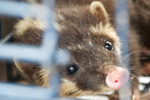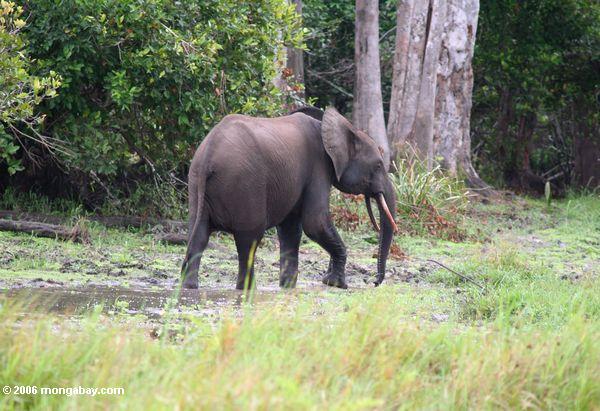Prince Charles has warned that criminal gangs are turning to animal poaching, an unprecedented slaughter of species that can only be stopped by waging war on the perpetrators, in the latest of a series of increasingly outspoken speeches about the environment.
Addressing a conference of conservationists at St James’s Palace in London, the Prince of Wales announced a meeting of heads of state to take place this autumn in London under government auspices to combat what he described as an emerging, militarized crisis.
“We face one of the most serious threats to wildlife ever, and we must treat it as a battle—because it is precisely that,” said Charles. “Organized bands of criminals are stealing and slaughtering elephants, rhinoceros and tigers, as well as large numbers of other species, in a way that has never been seen before. They are taking these animals, sometimes in unimaginably high numbers, using the weapons of war—assault rifles, silencers, night-vision equipment and helicopters.”
It is the second outspoken speech that Charles has made this month, at a time when he is taking on an increasing number of monarchical duties, after he told a group of forest scientists also at St James’s Palace that corporate lobbyists and climate change skeptics were turning the Earth into a “dying patient”. The Prince of Wales warned that iconic species—which could include rhinoceros, tigers, orangutans and others—could be extinct in the wild within a decade if efforts to protect them were not stepped up. “By urgent, I mean urgent,” he told the dignitaries, who included governmental and United Nations officials as well as NGOs and grassroots activists.
His son, the Duke of Cambridge, added to the plea: “My fear is that one of two things will stop the illegal trade: either we take action to stem the trade, or we will run out of the animals. There is no other outcome possible.”
Charles also stressed the need to deal with the demand for exotic species. In the past, much of the market for tiger parts, rhino horns and ivory was said to be driven by beliefs in traditional Chinese medicine, in which the rare animal parts were believed to have curative or aphrodisiac properties. But the prince dismissed such ideas, saying the trade was in fact about status symbols rather than belief systems. “The bulk of the intended use is no longer for products that can be classified as traditional medicines. Instead, many more people in rapidly growing economies are seeking exotic products that reflect their economic prosperity and status.”
The conference called for celebrities to publicize their outrage and opposition to the trade, and for young people in countries such as China to be educated to reject the demands of their parents for such status-fueled goods.
Forest elephant in Gabon.Ivory poachers have decimated forest elephant populations: a recent study found that 62 percent of forest elephants have been killed in the past ten years alone. Photo by: Rhett A. Butler.
Original Post: Prince Charles calls for war on animal poachers
Related articles
Gabon steps in to help protect elephants from ivory poaching at Central African Republic site
(05/18/2013) Gabon has agreed to help battle poaching in protected areas in the Central African Republic following an elephant massacre at a renowned World Heritage site, reports the Wildlife Conservation Society (WCS).
Five percent of ploughshare tortoise population perishes after botched smuggling attempt
(05/14/2013) In March, two people were caught attempting to smuggle 54 ploughshare tortoises (Astrochelys yniphora) into Thailand. Listed as Critically Endangered, the tortoises’ wild population is down to approximately 400-500 animals in its native Madagascar, meaning the smugglers were attempting to move over 10 percent of the total population. Now, the Scientific American blog Extinction Countdown reports that nearly half of the smuggled tortoises have died of unknown causes.
Elephants massacred for ivory in Central African Republic
(05/10/2013) Dozens of elephants have been slaughtered in the Dzanga Bai World Heritage Site in the Central African Republic just days after conservationists warned about an impending threat from the movement of 17 heavily armed poachers. The massacre occurred at a site renowned as ‘village of elephants’, where tourists and scientists have for decades observed wild elephants congregating at a large clearing to feed on minerals.
17 poachers allegedly enter elephant stronghold in Congo, conservationists fear massacre

(05/07/2013) Local researchers and wildlife guards say 17 armed elephant poachers have gained access to Dzanga Bai, a large waterhole and clearing where up to 200 forest elephants visit daily in the Central African Republic (CAR)’s Dzanga-Ndoki National Park. WWF, which works in the region but has recently evacuated due to rising violence, is calling on the CAR government to rapidly mobilize its military to stop another elephant bloodbath in central Africa. Elephants are being killed across their range for their ivory, which is mostly smuggled to East Asia.
A Tale of Two Elephants: celebrating the lives and mourning the deaths of Cirrocumulus and Ngampit

(05/07/2013) On March 21st, the organization Save the Elephants posted on their Facebook page that two African elephants had been poached inside a nearby reserve: “Sad news from the north of Kenya. Usually the national reserves are safe havens for elephants, and they know it. But in the last two weeks two of our study animals have been shot inside the Buffalo Springs reserve. First an 18 year-old bull called Ngampit and then, yesterday, 23 year-old female called Cirrocumulus (from the Clouds family).”

(04/25/2013) WWF and the Wildlife Conversation Society (WCS) are issuing an immediate call for action as they report that poachers are killing sizable numbers of forest elephants near the Dzanga-Sangha protected areas in the Central African Republic (CAR). The two large conservation groups have evacuated their staff from the area after a government coup, but local rangers are still trying to determine the scale of the killing while defending remaining elephants. In total the conservation groups believe the parks are home to over 3,000 elephants.
Bizarre, little-known carnivore sold as illegal pet in Indonesian markets (photo)

(04/24/2013) Few people have ever heard of the Javan ferret-badger, but that hasn’t stopped this animal—little-known even to scientists—from being sold in open markets in Jakarta according to a new paper in Small Carnivore Conservation. The Javan ferret-badger (Melogale orientalis) is one of five species in the ferret-badger family, which are smaller than proper badgers with long bushy tails and elongated faces; all five species are found in Asia.
(04/23/2013) Authorities in Vietnam arrested a man who they say was transporting 53 king cobras — a protected snake species — in his car, reports the Associated Press.
Rhino horn madness: over two rhinos killed a day in South Africa
(04/22/2013) Rhino poachers have killed 232 rhinos during 2013 so far in South Africa, reports Annamiticus, which averages out to 2.1 a day. The country has become a flashpoint for rhino poaching as it holds more rhinos than any other country on Earth. Rhinos are being slaughter for their horns, which are believed to be a curative in Chinese traditional medicine, although there is no evidence this is so.
Lions for sale: big game hunting combines with lion bone trade to threaten endangered cats
(04/18/2013) Koos Hermanus would rather not give names to the lions he breeds. So here, behind a 2.4-meter high electric fence, is 1R, a three-and-a-half-year-old male, who consumes 5kg of meat a day and weighs almost 200kg. It will only leave its enclosure once it has been “booked”‘ by a hunter, most of whom are from the United States. At that point the big cat will be set loose in the wild for the first time in its life, 96 hours before the hunt begins. It usually takes about four days to track down the prey, with the trophy hunter following its trail on foot, accompanied by big-game professionals including Hermanus. He currently has 14 lions at his property near Groot Marico, about two and a half hours by road west of Johannesburg.

